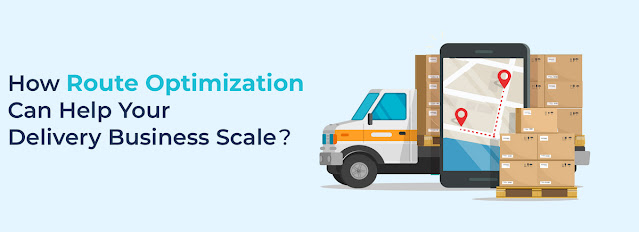What Is Route Optimization: How It Helps Businesses Scale
In the early days of commerce, route planning was a manual process, relying on local knowledge and physical maps. As businesses expanded, the need for efficient transportation became paramount.
The advent of technology brought about tools like "route software" and routing programs, transforming the way companies approached logistics.
Today, with the surge in e-commerce and global trade, logistics faces challenges like ever-changing traffic conditions, customer demands for faster deliveries, and the need for dynamic route optimization.
The quest for the best route optimization software and application is on, with businesses seeking solutions that offer both efficiency and cost-effectiveness.
What is Route Optimization?
2.1. Definition and Basics
Route optimization determines the most efficient route for a set of stops, considering various factors like distance, traffic, and time. It goes beyond traditional route planning, leveraging advanced algorithms and route optimization software to ensure timely deliveries and reduced costs.
2.2. The Science Behind the Process
At its core, route optimization is a complex mathematical problem. It involves analyzing vast amounts of data, from geocoding to traffic analysis. Modern route optimization free tools employ sophisticated algorithms, ensuring the optimized route is quick and cost-effective.
Furthermore, with the rise of routing optimization software, businesses can now factor in real-time data, making adjustments on the fly. This dynamic route optimization ensures that even unforeseen challenges, like road closures, are swiftly addressed.
Related: Measures to Implement for availing Finance for Trucks Business
The Importance of Route Optimization
3.1. Enhancing Operational Efficiency
Route optimization is pivotal for businesses aiming to streamline operations.
By optimizing routes, companies can:
- ensure timely deliveries,
- reduce idle time,
- and maximize the use of their fleet.
Tools like route optimizer and daily route planner are crucial in achieving this operational excellence.
3.2. Reducing Costs and Overheads
Fuel costs, vehicle maintenance, and driver wages can significantly impact a company's bottom line. By employing route optimization free tools or investing in the best route optimization software, businesses can drastically reduce these overheads, increasing profitability.
3.3. Boosting Customer Satisfaction
In today's competitive market, customer satisfaction is paramount. Route optimization ensures timely and accurate deliveries, leading to happy customers. Whether through a free route optimizer or premium routing software for small businesses, the end goal remains: delighted customers.
How Route Optimization Works
4.1. Data Collection and Analysis
The foundation of route optimization lies in data. From collecting route addresses to analyzing traffic patterns, data drives the optimization process.
Key components include:
- Geocoding: Translating addresses into GPS coordinates.
- Traffic Analysis: Understanding real-time traffic conditions.
- Vehicle Data: Analyzing vehicle capacity and fuel consumption.
- Driver Data: Factoring in driver schedules and preferences.
- Customer Preferences: Considering delivery time windows and specific requirements.
4.2. Algorithms and Computation
Once data is collected, route optimization software employs complex algorithms to determine the best route. These algorithms consider multiple scenarios, ensuring the chosen route is efficient and cost-effective.
Key aspects include:
- Traveling Salesman Problem (TSP): Finding the shortest possible route.
- Vehicle Routing Problem (VRP): Optimizing routes for multiple vehicles.
- Dynamic Programming: Adjusting routes based on real-time data.
- Heuristic Methods: Using shortcuts to find a near-optimal solution quickly.
- Machine Learning: Leveraging past data to predict future patterns.
4.3. Real-time Adjustments and Feedback
Modern route optimization software offers real-time adjustments. The software can recalibrate routes on the fly, whether a sudden road closure or a last-minute delivery request.
Key features include:
- Real-time Traffic Data: Adjusting routes based on current traffic conditions.
- Customer Feedback: Incorporating real-time feedback for future optimizations.
- Driver Input: Allowing drivers to provide insights and feedback.
- Dynamic Re-routing: Changing routes on the go based on unforeseen challenges.
- Predictive Analysis: Anticipating future challenges and adjusting routes proactively.
Key Components of Route Optimization
5.1. Geocoding and Address Recognition
Geocoding is the process of converting addresses into geographical coordinates. It's a crucial component of route optimization, ensuring accurate and efficient route planning. Modern route software employs advanced geocoding techniques, ensuring that even vague addresses are accurately pinpointed.
5.2. Traffic and Road Condition Analysis
Traffic conditions can significantly impact delivery times. By analyzing real-time traffic data, route optimization software can adjust routes on the fly, ensuring timely deliveries. Whether it's a traffic jam or a road closure, the software can recalibrate the route, ensuring minimal disruptions.
Related: Global Automotive Intelligent Door System Market
5.3. Vehicle and Driver Constraints
Every vehicle and driver has unique constraints. Whether it's a vehicle's capacity or a driver's working hours, these constraints play a crucial role in route optimization. By factoring in these constraints, businesses can ensure efficient deliveries and compliance with regulations.
Benefits for Different Business Sectors
6.1. Retail and E-commerce
The e-commerce boom has put immense pressure on logistics. Route optimization ensures timely deliveries, leading to increased customer satisfaction.
Key benefits include:
- Reduced Delivery Times: Faster deliveries lead to happy customers.
- Cost Savings: Optimized routes mean reduced fuel consumption and overheads.
- Scalability: Catering to increased demand during sale seasons.
- Real-time Tracking: Offering customers real-time delivery tracking.
- Enhanced Customer Experience: Ensuring accurate and timely deliveries.
6.2. Food and Grocery Delivery
In the food delivery sector, timeliness is paramount. Route optimization ensures hot and fresh deliveries, leading to repeat customers.
Key benefits include:
- Faster Deliveries: Ensuring food reaches customers hot and fresh.
- Dynamic Re-routing: Adjusting routes based on real-time challenges.
- Cost Efficiency: Reducing overheads and increasing profitability.
- Customer Feedback Integration: Incorporating feedback for future optimizations.
- Scalability: Catering to peak demand times like weekends and holidays.
6.3. Manufacturing and Distribution
For manufacturers and distributors, route optimization ensures timely deliveries to retailers and end customers.
Key benefits include:
- Inventory Management: Reducing stock holding costs.
- Just-in-time Deliveries: Ensuring timely deliveries to production units.
- Cost Savings: Reducing transportation overheads.
- Scalability: Catering to increased production during peak seasons.
- Real-time Tracking: Offering retailers real-time delivery tracking.
The Environmental Impact
7.1. Reducing Carbon Footprint
Route optimization plays a crucial role in reducing a company's carbon footprint. Businesses can reduce fuel consumption by ensuring efficient routes, leading to decreased carbon emissions.
Furthermore, with the rise of electric vehicles, route optimization can ensure that vehicles remain within charging range, promoting sustainable transportation.
7.2. Efficient Fuel Consumption
Fuel is one of the significant overheads for logistics companies. Route optimization ensures that vehicles take the shortest and most efficient route, reducing fuel consumption.
Moreover, route optimization can avoid traffic jams by factoring in real-time traffic data, further reducing idle fuel consumption.
7.3. Sustainable Business Practices
In today's world, sustainability is not just an environmental concern but a business imperative. Route optimization promotes sustainable business practices by reducing wastage in terms of fuel, time, or resources.
By adopting route optimization, businesses can position themselves as environmentally conscious brands, appealing to a growing segment of eco-aware customers.
Challenges in Implementing Route Optimization
8.1. Data Accuracy and Integrity
The underlying data needs to be accurate for route optimization to be effective. Inaccurate route addresses or outdated traffic data can lead to suboptimal routes. Ensuring data integrity is paramount for effective route optimization.
8.2. Resistance to Change
Implementing route optimization requires a shift in organizational culture. From drivers used to traditional methods to management skeptical about new technologies, resistance to change can be a significant challenge.
8.3. Integration with Existing Systems
Most businesses have existing IT systems in place. Integrating route optimization software with these systems can be a challenge. Whether it's compatibility issues or data migration challenges, integration requires careful planning and execution.
Future of Route Optimization
9.1. Integration with AI and Machine Learning
The future of route optimization lies in AI and machine learning. AI can predict future patterns by analyzing past data, ensuring even more efficient route planning. Whether anticipating traffic jams or predicting delivery windows, AI is set to revolutionize route optimization.
9.2. Predictive Analysis and Forecasting
Predictive analysis can play a crucial role in route optimization. Businesses can proactively adjust routes by forecasting future challenges and ensuring uninterrupted deliveries.
9.3. The Role of IoT and Smart Cities
With the rise of smart cities, IoT devices will play a pivotal role in route optimization. From bright traffic lights to real-time road condition sensors, IoT will provide a wealth of data, driving the next wave of route optimization.
Case Study: A Business Transformation Story
10.1. The Problem Statement
A leading e-commerce company was facing challenges with timely deliveries. The traditional route planning methods were proving inadequate with a growing customer base and increasing delivery volumes.
10.2. Implementing Route Optimization
The company decided to invest in route optimization software. By integrating real-time traffic data and leveraging advanced algorithms, the software recalibrated routes on the fly, ensuring timely deliveries.
10.3. Results and Impact
Post-implementation, the company saw a 30% reduction in delivery times and a 20% reduction in fuel costs. Customer satisfaction scores soared, and the company could handle increased delivery volumes without adding to the fleet.
Summary
Route optimization is no longer a luxury but a necessity for modern businesses. Companies can reduce costs, enhance customer satisfaction, and promote sustainable business practices by ensuring efficient routes.
The future of route optimization is bright. With AI, machine learning, and IoT advancements, route optimization is set to become even more efficient, driving business growth and promoting sustainability.
Author: Jordan McKenzie is a seasoned content writer with over two decades in the tech industry. Having worked with top tech firms, Jordan combines deep technological insights with a passion for writing. With expertise ranging from AI to IoT, Jordan's articles demystify complex concepts, making them accessible to a broad audience. Apart from tech writing, Jordan has several published works and often conducts workshops on content creation. A true tech enthusiast at heart, Jordan bridges the gap between innovation and storytelling.





